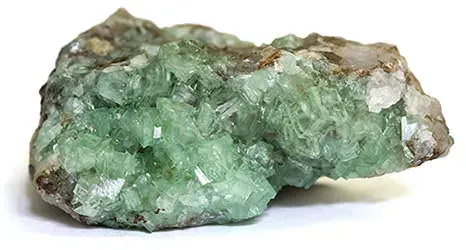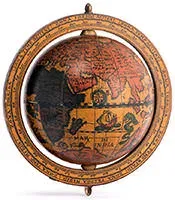 Smithsonite is usually found as bluish-green or green botryoidal masses or soft layers. The unique rounded and bubbly shape of smithsonite samples attracts collectors. They have a botryoidal crystal shape, which means they resemble a bunch of grapes. These crystals are usually shaped and polished and used as ornamental stones as they are commonly too soft to be used for jewelry. As ornamental stones, smithsonite is known as bonamite. Smithsonite may also be colored pink by the presence of cobalt, or yellow by the presence of cadmium. Smithsonite crystals are sometimes found, but are faceted for the collector only. Smithsonite is a brittle, vitreous, and translucent stone. It rates a 4-5 on the hardness scale. Smithsonite was named after James Smithson, the British geologist who first defined the mineral. Mr. Smithson left his fortune upon his death to be used to found the Smithsonian institution in Washington DC.
Smithsonite is usually found as bluish-green or green botryoidal masses or soft layers. The unique rounded and bubbly shape of smithsonite samples attracts collectors. They have a botryoidal crystal shape, which means they resemble a bunch of grapes. These crystals are usually shaped and polished and used as ornamental stones as they are commonly too soft to be used for jewelry. As ornamental stones, smithsonite is known as bonamite. Smithsonite may also be colored pink by the presence of cobalt, or yellow by the presence of cadmium. Smithsonite crystals are sometimes found, but are faceted for the collector only. Smithsonite is a brittle, vitreous, and translucent stone. It rates a 4-5 on the hardness scale. Smithsonite was named after James Smithson, the British geologist who first defined the mineral. Mr. Smithson left his fortune upon his death to be used to found the Smithsonian institution in Washington DC.
 Smithsonite is found in the oxidized zone of ore deposits carrying zinc minerals. It is commonly found in association with sphalerite, hemimorphite, galena and calcite. Smithsonite generally forms in dry climates. Though its official chemical composition makes it a zinc carbonate, other minerals often replace some of its zinc, which gives the stone its unique color. When basalt is present, the stone takes on a pink to rose tint. The best examples of this colored version of the stone come from the Tsumeb mine in Northern Namibia, and the Kabwe mine in central Zambia. Cadmium gives smithsonite a yellow color, and this form of the stone is known as cadmium smithsonite. In the best-known mix, copper makes the smithsonite stone appear green or blue. The most sought after color of smithsonite is purple to lavender.
Smithsonite is found in the oxidized zone of ore deposits carrying zinc minerals. It is commonly found in association with sphalerite, hemimorphite, galena and calcite. Smithsonite generally forms in dry climates. Though its official chemical composition makes it a zinc carbonate, other minerals often replace some of its zinc, which gives the stone its unique color. When basalt is present, the stone takes on a pink to rose tint. The best examples of this colored version of the stone come from the Tsumeb mine in Northern Namibia, and the Kabwe mine in central Zambia. Cadmium gives smithsonite a yellow color, and this form of the stone is known as cadmium smithsonite. In the best-known mix, copper makes the smithsonite stone appear green or blue. The most sought after color of smithsonite is purple to lavender.
 Colorless smithsonite is found in Namibia, Zambia. Blue green smithsonite is found in the United States, Spain and Greece. Yellow varieties of the stone are also found in the United States as well as in Sardinia. Various colored smithsonite stones are also found in Mausbach, North Rhine-Westphalia, in Western Germany.
Colorless smithsonite is found in Namibia, Zambia. Blue green smithsonite is found in the United States, Spain and Greece. Yellow varieties of the stone are also found in the United States as well as in Sardinia. Various colored smithsonite stones are also found in Mausbach, North Rhine-Westphalia, in Western Germany.
 There are many beliefs as to the emotional attributes of smithsonite. Such beliefs are actually specific to each color of smithsonite. Blue shades of the stone are said to help open one up to repressed emotions, in order to clear and heal these painful feelings of grief, rage, anger, resentment, sadness, sorrow, and heartache. These blue stones supposedly have the power to heal the fear of ones own emotions, and refill the aura with peace, healing, and security. Pink colored stones aid in trusting others and ourselves. These stones are known to open one up in order to let others in, let down walls that block ones growth and joy, and open the heart. They can help one to learn to love and give to others, releasing resentment and blame, and helping to forgive others and oneself. Overall, smithsonite is a stone that prepares us for new tasks and encourages us to make changes. It reminds us that change brings us forward and lets us grow.
There are many beliefs as to the emotional attributes of smithsonite. Such beliefs are actually specific to each color of smithsonite. Blue shades of the stone are said to help open one up to repressed emotions, in order to clear and heal these painful feelings of grief, rage, anger, resentment, sadness, sorrow, and heartache. These blue stones supposedly have the power to heal the fear of ones own emotions, and refill the aura with peace, healing, and security. Pink colored stones aid in trusting others and ourselves. These stones are known to open one up in order to let others in, let down walls that block ones growth and joy, and open the heart. They can help one to learn to love and give to others, releasing resentment and blame, and helping to forgive others and oneself. Overall, smithsonite is a stone that prepares us for new tasks and encourages us to make changes. It reminds us that change brings us forward and lets us grow.